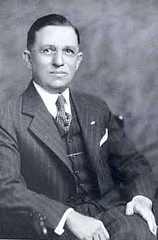
About UsThe Numismatic Bibliomania Society is a non-profit organization promoting numismatic literature. For more information please see our web site at coinbooks.org SubscriptionsThose wishing to become new E-Sylum subscribers (or wishing to Unsubscribe) can go to the following web page link MembershipThere is a membership application available on the web site Membership Application To join, print the application and return it with your check to the address printed on the application. Membership is only $15 to addresses in the U.S., $20 for First Class mail, and $25 elsewhere. For those without web access, write to: David M. Sundman, Secretary/TreasurerNumismatic Bibliomania
Society AsylumFor Asylum mailing address changes and other membership questions, contact David at this email address: dsundman@LittletonCoin.com SubmissionsTo submit items for publication in The E-Sylum, just Reply to this message, or write to the Editor at this address: whomren@coinlibrary.com
BUY THE BOOK BEFORE THE COINYou won't regret it! |
- WAYNE'S WORDS: THE E-SYLUM NOVEMBER 1, 2009
- FANNING NUMISMATIC LITERATURE AUCTION III CATALOG AVAILABLE
- LAKE BOOKS SALE #100 PRICES REALIZED AVAILABLE
- NEW REVISION: PHILIPPINE EMERGENCY AND GUERILLA CURRENCY
- WEIDAUER TRANSLATION PROJECT COMPLETE
- ANA DEBUTS ONLINE BEBEE PAPER MONEY COLLECTION EXHIBIT
- MORE ON CLICHÉS
- VOCABULARY WORD: CARTOUCHE
- READER THOUGHTS ON E-SYLUM ADVERTISING
- B. MAX MEHL, PNEUMATIC BROKER
- QUERY: REPRINT OF THE FIRST SIX VOLUMES OF THE NUMISMATIST
- ANSWER: GREEK COIN BOOK RECOMMENDATIONS
- TOKEN COLLECTORS NAME AWARD FOR JAMES J. CURTO
- MORE ON LEATHER MEDAL POUCHES CONNECTED TO LOUIS ST. GAUDENS
- BIRCH CENT PRE-AUCTION MANEUVERING
- INTERVIEW: THE IMPORTANCE OF COINS FOR THE AMERICAN ECONOMY
- CONGRESSIONAL GOLD MEDAL AWARDED TO SENATOR BROOKE
- MORE ON U.S. MINT DIRECTOR JAY JOHNSON
- ERRATA FROM LAST WEEK'S ISSUE
- WHEN ARE 200 ONE DOLLAR BILLS WORTH $10 MILLION?
- ASHMOLEAN REOPENS AFTER RENOVATIONS
- ANCIENT HISTORY AND PSEUDOSCHOLARSHIP
- CAN YOU FOOL A BREATHALYSER BY SUCKING A COPPER COIN?
- FEATURED WEB SITE: HANDBOOK OF BIBLICAL NUMISMATICS
WAYNE'S WORDS: THE E-SYLUM NOVEMBER 1, 2009

No new subscribers THIS week, either - we still have 1,268 readers. Please pass the word - who do you know that would enjoy The E-Sylum?
This week we open with details of David Fanning's Auction III of numismatic literature. Some great stuff in this sale! Also, we learn of a new book revision by Neil Shafer and the completion of a translation project on Early Electrum Coinage.
Dick Johnson treats us to another great numismatic vocabulary word, and another museum has one of the "Saint-Gaudens" leather medal pouches mentioned last week. To learn about a famous Pneumatic Broker, and how 200 one dollar bills can add up to $10 million, read on.
Wayne Homren
Numismatic Bibliomania Society
FANNING NUMISMATIC LITERATURE AUCTION III CATALOG AVAILABLE
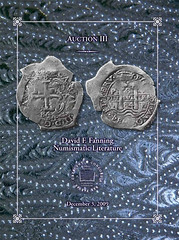 David F. Fanning Numismatic Literature has announced the availability of the catalogue of their third mail-bid auction of numismatic literature. The auction closes on Thursday, December 3, and features a wide variety of material from around the world, including works from the libraries of John J. Ford, Jr. and Douglas Ball. Some highlights include:
David F. Fanning Numismatic Literature has announced the availability of the catalogue of their third mail-bid auction of numismatic literature. The auction closes on Thursday, December 3, and features a wide variety of material from around the world, including works from the libraries of John J. Ford, Jr. and Douglas Ball. Some highlights include:
- F.C.C. Boyd Inventories of His Connecticut and New Jersey Coppers, with Additional Notes Pertaining to Continental Currency Dollars and Immune Columbia Pieces
- 1836 Manuscript Court Records of a Counterfeiting Case with the Bad Bill in Question Attached
- Correspondence from John J. Ford and Paul Franklin
- 1795 Supplementary Mint Act Signed in Ink by Secretary of State Edmund Randolph, Establishing Position of Melter and Refiner, Authorizing Reduction in Weight of Cents and Half Cents, and Providing for Their Distribution
- Third and Fifth Edition Red Books Inscribed by Yeoman to Contributor Hubert Polzer
- John J. Ford, Jr.'s Set of Inscribed Red Books
- The Very Scarce 1917 ANA Sale, Signed by Cataloguer Wayte Raymond
- A Complete Set of Hardcover Ford Catalogues (Stack's)
- ANS Library Catalogue, Complete in 11 Volumes, Including the Rare Third Supplement
- The First 40 Volumes of the Canadian Numismatic Journal
- A Substantial Run of Spink's Numismatic Circular
- Quarto Charpentier on the Medals of Louis XIV
- 18th-Century Lima Mint Ordinances
- Meili on the Paper Money of Brazil
- A Remarkable Archive of Manuscript Notes and Plates on Medieval France
The hard-copy catalogues are currently being printed and will mail in the next week or so. A PDF of the catalogue can be downloaded immediately from the www.fanningbooks.com Web site. The sale features nearly 700 lots and the catalogue is illustrated. To request a copy of the printed catalogue, please contact David Fanning at dfanning@columbus.rr.com. For more information, see the company's Web site at www.fanningbooks.com .
LAKE BOOKS SALE #100 PRICES REALIZED AVAILABLE
Fred Lake has announced that the prices realized for his 100th sale of numismatic literature have been posted on his web site. The sale included selections from the library of J. Roger Persichilli and other consignors.
For more information, see: www.lakebooks.com/
NEW REVISION: PHILIPPINE EMERGENCY AND GUERILLA CURRENCY
Philippine specialist Ray Czahor of Cookie Jar Collectibles in Columbia, MD writes:
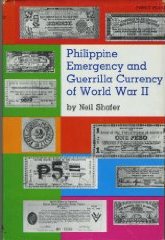 Great News: Neil Shafer has started the revision to his "Philippine Emergency and Guerilla Currency of World War II" which he issued in 1974. The revision will start as chapters to be published in Bank Note Reporter.
Great News: Neil Shafer has started the revision to his "Philippine Emergency and Guerilla Currency of World War II" which he issued in 1974. The revision will start as chapters to be published in Bank Note Reporter.
The first chapter will center on the SCARCE Aklan issues and is planned for the December 2009 issue. I will assist Neil on notes and information that were in the C.M Nielsen collection I bought last year. Strongly suggest you get a subscription to Bank Note Reporter if you don't do so already.
WEIDAUER TRANSLATION PROJECT COMPLETE
Lisa Weidauer's 1975 book Probleme der frühen Elektronprägung (Problems in Early Electrum Coinage) is one of the standard references, frequently used in coin attributions, for what are arguably the world's first coins. Many of us know enough German to understand auction catalogs but not books such as this one.
The project to translate Dr. Weidauer's book, announced here earlier, is now complete.
This past April I asked about a half dozen European auction houses if they knew of Dr. Weidauer and how to contact her, and if so to forward to her my email inquiry about having her book translated into English. I received a cooperative response from Münzen & Medaillen, which graciously indicated they would write her a letter and enclose a print-out of my email. Dr. Weidauer responded to me via email in May.
I had asked Dr. Weidauer's permission for a group of us to have her 114-page book, still important 34 years later, translated into English so we could better understand her thinking about this fascinating subject. She replied, in part, "I am glad to hear that my book is used and of course a translation into English will be much easier for you. I'm quite willing to give the permission." An effort to contact the publisher went unanswered, with the publisher perhaps wondering, understandably, why we were bothering them about a book that has been out of print for more than a quarter of a century.
The next step was finding a translator. To make a long story shorter, Dane Kurth, widely known online as the current administrator of the online auction archive service Wildwinds.com, agreed to take on the task. She did a marvelous job, truly outstanding, not only handling the translation, including the numismatic terms, but also retaining the same pagination of the original (she placed some of the shorter footnotes into the body of the text and others at the end of the particular page) and even incorporating into the text small scans of the Lydian script of coin legends. I did some copyediting/proofreading afterward. I don't expect Dane to be terribly eager to do another project like this as she said when finished that she was glad it was over! Kudos again to Dane for her efforts.
We have two versions of the translation, one in an early Microsoft Word (1.x) format so it will be widely accessible, the other a PDF version for anybody who can't read or import the Word file (all you need for PDF files is Adobe Reader, which is a free download). The Word and PDF files, which contain the same information, are of the text and the catalog (descriptions of coins illustrated in plates) of the book. Not included are scans of the 29 plates of coin and other photos.
This effort was never intended as a republication of this book, just a translation aimed at people who have already bought it and want to better understand it. That's what I asked permission for, and that's what I received. The translation therefore will primarily be useful to people who already have Probleme der frühen Elektronprägung. If you don't have the book, you should be able to find a copy from an ancient numismatic bookseller.
The way Dane and I decided to set this up was for me to handle responding to inquiries, receiving payments, and emailing out her translation. This is not a for-profit effort but an expense-sharing effort. I don't know exactly how many people will want this translation, though after putting out feelers earlier this year it appears that it will be relatively few. So we decided to set a fee of $20 for anybody who wants a copy of the translation emailed to them. This is an email-only project. I won't be able to mail out printed pages. For payment PayPal is preferred, and payment must be in American dollars.
If you'd like to purchase a copy, let me know if you want a Word DOC file (3.2 MB in size) or Adobe PDF file (1.4 MB in size) by sending an email to: weidauerproject@gmail.com .
For early electrum buffs, you'll likely find some material in Dr. Weidauer's book you agree with and some you disagree with. I did.
Perhaps others might consider similar efforts to translate other key books in their specialty areas. Like putting up numismatic Web sites, I look at translation projects as a good way of spreading numismatic knowledge and enjoyment.
To read the earlier E-Sylum article, see: WEIDAUER TRANSLATION PROJECT (www.coinbooks.org/esylum_v12n03a14.html)
ANA DEBUTS ONLINE BEBEE PAPER MONEY COLLECTION EXHIBIT

The American Numismatic Association Bebee Collection of paper money, one of the finest collections of United States paper money ever assembled, is available to view in an exciting new online image gallery. The collection, consisting of more than 800 notes, was donated to the ANA by Aubrey and Adeline Bebee in 1988.
To view the Bebee Collection online gallery, go to www.money.org (select "Visit the Money Museum," then select "The ANA Bebee Collection of U.S. Paper Money/View the Collection") or go to www.ana-museum.org. Additional educational information, including introductions explaining the cross-referenced components of the notes, will be added in the coming months.
The gallery is the work of longtime ANA members John Nebel and Susie Nulty. The collection was scanned seven years ago using the highest quality scanner, enabling minute details to be shown. The original files have been reduced to a practical size for web viewing, but small details are shown in high resolution through pop-up windows.
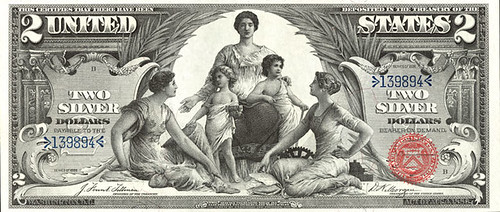
The notes are cross-referenced by portraits, Friedberg numbers, date, denomination, territory or state, and vignettes. There are special sections for error notes and outstanding specimens, and an introduction by Arthur L. Friedberg, renowned paper money expert and author of A Guide to United States Paper Money.
"It's rewarding to work on such an interesting and worthwhile project," said Nulty. "John and I tried to design a site that is easy to navigate and includes several cross-referencing options. Our hope is that fellow ANA members enjoy the gallery and it becomes a great research tool for anyone interested in U.S. paper money."
Aubrey (ANA Life Member 110) and Adeline (Life Member 4570) Bebee were among the most prominent numismatic collectors of the 20th century, and were ardent supporters of the ANA. Aubrey began assembling his world-class collection of U.S. paper money in 1941.
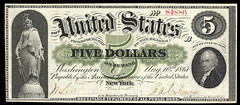
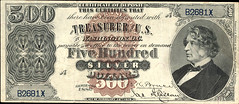
The Bebees also donated an 1804 dollar (Idler/Bebee specimen) and 1913 Liberty Head nickel (McDermott/Bebee specimen) to the ANA Edward C. Rochette Money Museum, along with several other prominent pieces. The Beebes received the Farran Zerbe Memorial Award in 1988 and the Lifetime Achievement Award in 1992; Aubrey received the Medal of Merit in 1968. Aubrey Bebee passed away in 1992 and Adeline passed away in 1998.
THE BOOK BAZARRE
MORE ON CLICHÉS
Regarding last week's discussion on clichés, Serge Pelletier writes:
Concerning the word "cliché" it is used in French as follows:
- For what is often called a "lead": Imprint of a die during the manufacturing process. It is often taken on pewter or lead.
- For "electrotype": A reproduction of a coin or medal made by an electroplating process.
(From my The Canadian Dictionary of Numismatics | Le dictionnaire canadien de numismatique)
"Cliché" in non-numismatic French means "snapshot" (as in photo), so its numismatic use is very logical since it is a snapshot of a die. Can't see how it can be related to the sound of a press!
Joe Boling writes:
Another use for the term cliché, also dealing with thin metallic objects, is in stamp printing. Back in the days before siderography, and when stamps were printed using letterpress technology, sheets of stamps were printed from frames of individual stamp clichés locked into place. One of the most famous stamp errors, the Swedish 3 skilling banco in yellow, was probably created when a 3 skilling banco cliché was mistakenly inserted into a plate of 8 skilling banco clichés, and the resulting stamp was printed in the yellow color of the 8 (the 3 was supposed to be blue-green).
Clichés were made by stereotyping (casting from a master image), and another definition of stereotyper is a machine that creates embossed plates - thus the embossing that Dick Hanscom's original query described.
The use of the word cliché there has nothing to do with its use by a medal maker. And I have to take exception to Dick Johnson's (perhaps tongue in cheek) statement that "The term cliché comes from the sound the press made when striking these ...." The term cliché comes from the French for stereotype (as a verb) - and is carried into English as yet another (but not unrelated) definition of stereotype - a hackneyed phrase, a repeated reference - because, in its original use, clichés were all alike.
To read the earlier E-Sylum article, see: VOCABULARY WORD: CLICHÉ (www.coinbooks.org/esylum_v12n43a13.html)
VOCABULARY WORD: CARTOUCHE
Last week in The E-Sylum I described the word cliché in response to an inquiry from Dick Hanscom. That word was one of two words that I first learned when, as a 36-year old numismatist, I was hired at Medallic Art Company in 1966. Despite the fact I had been a coin collector for 25 years and had studied Frey's "Dictionary of Numismatics" (see E-Sylum vol 12, no 23, art 11 ) I realized I had a lot more terminology to learn as a writer for a medal manufacturing firm. Medallists have their own jargon.
I asked a lot of questions from staff members at Medallic Art. They were patient with my incessant inquiring. They answered my questions and often showed me examples of what a word or term meant. I was trained in all things medallic by Julius Lauth, vice president and art director, but everyone answered my questions, particularly workmen on the pressroom floor.
When I heard a word that I did not know, I stopped whoever was talking and asked a question. The second word I asked about was "cartouche." What's a cartouche?
Answer: It's a panel intended for lettering. In a medallic design it is an area purposely left open, the area is call a "reserve." But it's a cartouche when it has a border surrounding the open area. Lettering can be in the die, or if left open it can be inscribed later within the cartouche after the piece is struck. As such a cartouche is particularly useful for an award medal as it aids in customizing the medal by inscribing a recipient's name, date, and often, details of the award.
A cartouche can be any shape, usually rectangular or square, or even contained in a ribbon. Originally it came from a scroll, with rolled edges, but evolved into a tablet-like shape, and later in simpler forms.
A cartouche is often the location for an "insert die" which I described in detail in an article on the Carnegie Hero Medals, in the October 2006 issue of The Numismatist (p 50-53.) The insert leaves a minute gap surrounding it. This is usually just inside the border of the cartouche.
Collectors encounter medals both inscribed, or "uninscribed cartouche" -- without any lettering therein. Really cheap organizations bestow uninscribed medals with the instructions for the recipient to have his jeweler engrave the appropriate inscription (but this seldom occurs).
There is a nameplate shape called "cartouche" -- rectangular with circular clipped corners -- often applied to paintings and such. It comes from the Italian word cartoccio. It means nameplate. Also is fun to say cartoccio.
READER THOUGHTS ON E-SYLUM ADVERTISING
Last week I wrote:It has been suggested that advertisements in The E-Sylum be grouped together in a single section like any other article. What do readers think? Opinions of the dealers who pay for the ads will be weighted heavily in the final decision, but I would like to hear from readers.
Tom Caldwell of Northeast Numismatics writes:
I would say list all the advertisers together, and we would have an interest in being one of the advertisers.
On the other hand, Martin Kaplan writes:
Here are my two cents on ads: If you put them in a special section, why would I go there? Curiosity? Maybe once but then never again? That is not fair to the advertiser, who should get "credit", i.e., visibility in every E-Sylum for their advertising dollars. As a reader, have the ads hit me in the face! I can scroll down over them.
Ron Abler writes:
Readers who think that your arrangement of ads in your free newsletter is inconvenient to them should be invited to contribute time like you do and money like your advertisers do. When their contributions equal or exceed yours, give them a say. Until then, just keep up the good work!
Michael Luck writes:
Please keep up the good work, and thanks for letting readers give their comments. I think it adds a little bit of spice not to see all the ads grouped together - it makes them more individual and interesting.
When I read about numismatic books in The E-Sylum and see book dealer ads it sometimes gets my interest and I click to look for something I just read about. I have learned many things when I clicked the ads interspaced between the newsletter information.
It is not bothersome at all as the ads are well presented and easily ignored if you want to by-pass them.
For me this newsletter is a great service and fun just the way it is - brilliant, if I do say so myself. If it ain't broke don't fix it!!
We may have to forego a potential new advertiser, but the majority would still be against a single block of ads. So the status quo it is. Thanks to all who chimed in with their thoughts. -Editor
B. MAX MEHL, PNEUMATIC BROKER
Federal Census enumerator Lillie M. Patterson was working on South Adams Street on April 8, 1930, when she arrived at the residence of B. Max Mehl. The actual street number is illegible, but appears to be 2512.
He lived there with his wife Ethel, and their daughters Loraine and Danna. Mehl and his wife were 42 and 39 years old, Loraine was 19, and Danna was 13. In the home with them were Madie and Claude Davis, a maid and servant. Especially surprising is the "new information" that Max and Ethel were both born in Texas, and that their parents were all born in Texas as well!
He obviously lived in a very nice section of Ft. Worth. His home was valued at $30,000, and all the homes in his block were valued between $20,000 and $35,000. His immediate neighbors were employed as a manager of a cattle ranch, and a vice president of a contracting company. Living nearby were a surgeon, two lawyers, and an architect. Perhaps most surprising is Mehl's occupation. The Census enumerator recorded that Max Mehl was a "Pneumatic Broker." It would seem that Mehl must have bought and sold all things Pneumatic.
While humorous, this record provides a lesson in research, that we cannot always assume that historical records are correct. Corroborating evidence is often required. In the case of Mehl, going back to the previous decade, we find his occupation as a dealer in old coins, and that he was born in Russia, facts that we know are correct.
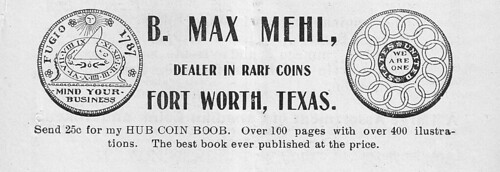
THE BOOK BAZARRE
QUERY: REPRINT OF THE FIRST SIX VOLUMES OF THE NUMISMATIST
The recent mail bid sale of David Sklow offered as lot #257 the reprint of the first six vols. of the Numismatist. This item was published in Kansas in 1963. I just happened to look through the June, 1948 issue of The Numismatist, and there on page 405, called "The President's Page", is the following article:
There are probably less than ten complete sets in existence and because of the extreme rarity of the first six volumes most collectors are discouraged from trying to complete a set.
To remedy this, the A.N.A. Board of Governors has authorized the reprinting of the first six volumes, and as soon as 100 orders are received the work will begin.
The first six volumes, issued from 1888 to 1893, will be bound in one volume. The price has been set at $8 for those who order it in advance.
Send your order as soon as possible to T.R. Hammer, Librarian, P.O. Box 577, Wichita 1, Kansas".
I would like to know if any of our members, especially the over 65 age group might have ordered the reprint way back at $8. Does anyone have an answer to why 15 years would pass (from 1948 till 1963), to receive 100 orders, before it was printed? By the way, the lot sold for $710.00.
ANSWER: GREEK COIN BOOK RECOMMENDATIONS
Last week Ben Moore wrote:
I have a collection of over 30 Greek coins - most are square, such as Eukratides, Apollo and Lysias. I am new to collecting Greek coins and wonder if there a book or software you can recommend to me.
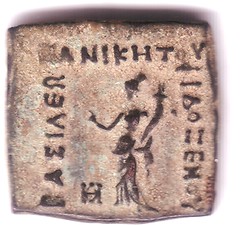
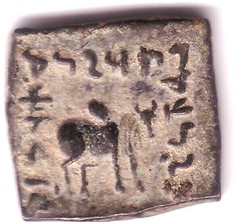
John Nebel writes:
This coin is probably Philoxenos, Indo-Greek, 110-80 BC. It would help to know the weight and be certain about the metal, but guessing:
O: Demeter holding a cornucopia, mint mark Pushkalavati, AE hemi-obol
![]()
R: Humped bull
Maharajasa apadihatasa Philasinasa
The references are:
- Mitchiner, Indo-Greek and Indo-Scythian Coinage (this coin in Volume 3) and
- Bopearachchi; Monnaies Greco-Bactriennes Et Indo Grecques Catalogue Raisonne, Bibliotheque Nationale, Paris, 1991, 459 Pages, 69 plates
- SNG ANS Part 9 (Bopearachchi)
TOKEN COLLECTORS NAME AWARD FOR JAMES J. CURTO
NBS member Jerry Adams writes:
I am on the board of directors for NTCA (National Token Collectors Assoc.) which is the largest group of collectors of trade tokens in the world, with over 500 members. We publish a monthly hard copy magazine. We are starting up a new award open to NTCA members only, to be presented annually to the member who is voted to have published the best book on tokens/exonumia in the last year.
The National Token Collectors Association (NTCA) a group of 500 collectors of trade tokens has just initiated the "James J. Curto Annual Award." The award will be presented to the NTCA member voted to have written the best book on exonumia in the preceding year.
The award is named in honor of numismatist James J. Curto (1902-1993). Curto was the author of "Military Tokens of the United States" (1970), "Military Tokens of the United States II" (1978), "Indian & Post Trader Tokens" (1951), "Post Exchange, Canteen and Other Military Tokens" (1954), "Sutlers and Their Tokens" (1946), and other books which set a high standard for research and publication. Mr. Curto resided in Grosse Point, Michigan and was a member of the American Numismatic Association.
The first award will be announced by NTCA in April 2010. Information inquiries may be addressed to Jerry Adams at RED13STARWOOD@YAHOO.COM .
Jerry adds:
Curto was an avid token collector and specialized in military tokens and tokens of Post traders and Indian traders. We wanted to honor him by naming the award after him, which I think is fitting.
MORE ON LEATHER MEDAL POUCHES CONNECTED TO LOUIS ST. GAUDENS
Unfortunately family obligations kept me from attending the COAC conference and I hadn't seen an image of the Saint-Gaudens leather pouch until you ran it this week. You mentioned it in the summary of the conference the week before but it wasn't until I saw the actual image that the bell went off. We have one of these too.
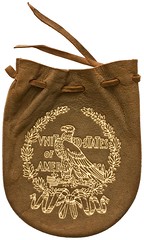
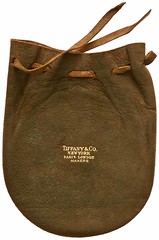
The American Numismatic Society pouch
Our pouch came with a medal inside of it and the wear pattern on the pouch is consistent with the medal that was inside. But sadly we don't have — and we have never had — one of the inaugural medals. But like the ANS's example, there is a Louis St. Gaudens connection.
Our medal is Louis's Franklin Bicentennial Medal from 1906. It was purchased by Cornelius Vermeule at Christie's New York (Sale 6652, September 20, 1988) and given to our museum in 1989. It came with the pouch but the pouch is not illustrated or mentioned in the sale catalogue. There is a picture of both on our website if you enter the accession number 1989.843a-b into the search box under in the collections section: www.mfa.org/collections/ .
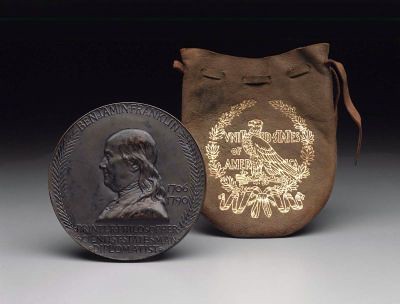
The Museum of Fine Arts pouch
In the correspondence in our file Cornelius says that the pouch was designed by Augustus at the time he was working on the Eagle and the Double Eagle and that it was used for this medal. There is nothing else in the file to say where he got that information or whether or not he was speculating. But it does seem possible (since the brothers worked so closely together) that this pouch is for Louis's commission and not Augustus's. Perhaps it was used for both.
To read the earlier E-Sylum article, see: SAINT-GAUDENS' 1905 ROOSEVELT INAUGURATION MEDAL LEATHER POUCH (www.coinbooks.org/esylum_v12n43a15.html)
BIRCH CENT PRE-AUCTION MANEUVERING
Neil Berman's comment on John Ford's auction ethics reminded me of a similar experience at Bowers & Merena's November 14-15, 1988 Norweb part III sale in New York City.
For many years, and until today, I've sought to add a nice 1792 Birch cent to my 1792 U.S. pattern collection which lacks that coin and the 1792 Wright quarter to be complete.
The 1988 Norweb part III sale contained two Birch cents. I liked the 1st one, a smooth problem-free VF, delightful light brown color. The second (Ex Fine) had unsightly right field tooling. I'd figured to bid up to $70K hammer ($77K total at the time) until Ford, during lot viewing, told me it was fake.
I decided Ford knew best and I did not bid. It hammered for $32K to Tony Terranova and immediately sold privately to Denis Loring for another large cent collector. It was indeed genuine. Today, it is in the Smithsonian and forever out of "numismatic circulation" - donated by Stack's some years later.
The 1792 Birch cent is one of a handful of truly rare American coins, so rare that all the money and contacts in the world matter little. It's the opportunity to acquire one that matters.
Emery May Norweb did in fact own three Birch cents - probably unprecedented in numismatic history. The dark About Unc pictured enlarged in color on the Norweb III sale poster was in fact fake and did not appear in her auction sale. So whether Ford confused the two coins or was disingenuous to me in calling the Norweb auction coin fake, to this day I'm uncertain. But I can guess...
To read the previous E-Sylum article, see: JOHN FORD'S PRE-AUCTION MANEUVERING (www.coinbooks.org/esylum_v12n43a11.html)
INTERVIEW: THE IMPORTANCE OF COINS FOR THE AMERICAN ECONOMY
![]() Last week I mentioned that I'd been asked to be interviewed by the Washington correspondent of a Brazilian TV station, GloboNews.
Reporter Raquel Krahenbuhl wrote:
Last week I mentioned that I'd been asked to be interviewed by the Washington correspondent of a Brazilian TV station, GloboNews.
Reporter Raquel Krahenbuhl wrote:
"I am doing a story on the current condition of coins (penny, nickel, dime, quarter) currency in the United States, and the importance those coins for the American economy.
The story is getting attention in Brazil because coins are being used less and less in the marketplace due to usage of credit and debit cards. Now the Brazilian government is planning to launch a campaign to promote usage of coins."
Dick Johnson kindly forwarded me these talking points just before she arrived at the lobby of my office building around 9:30am Monday:
- Progressive nations -- Australia, New Zealand, Finland, Israel -- have abolished low value coins as their economic value has diminished.
- More nations will also abolish low value coins and round off to next higher denomination coin, this effects economies and efficiencies.
- European nations learned they have too many Euro coin denominations -- five or six is ideal -- not eight different as some have.
- Half dollars are least circulated U.S. coin denomination.
- Ultimately U.S. will have only a dime, half dollar and dollar coin of existing denominations, the cent, nickel and quarter will be abolished.
- New U.S. coin denominations will be Five and Ten dollar coins.
- Coins will continue to be used for cash transactions and for vending machine use.
Her cameraman set up tripods for his camera and lights, and before long the interview was underway. I hadn't studied, so I winged it. I think it went fairly well, though. Her questions were easy, although I had to dance around my lack of knowledge of the actual numbers of coins involved.
The story was aired on Tuesday, but unfortunately is not available on the web site.
CONGRESSIONAL GOLD MEDAL AWARDED TO SENATOR BROOKE
President Obama today presented former U.S. Senator Edward William Brooke III with the Congressional Gold Medal for his unprecedented and enduring service to the Nation. The ceremony was held in the U.S. Capitol Rotunda.
The Congressional Gold Medal, designed and struck by the United States Mint, honors Senator Brooke's pioneering accomplishments in public service. Senator Brooke broke new ground at a time when few African-Americans held state or Federal office. He was the first African-American elected to the U.S. Senate by popular vote, serving with distinction for two terms, from January 3, 1967, to January 3, 1979. During his first term, Brooke was appointed to the President's Commission on Civil Disorders, where his work on discrimination in housing served as the basis for the 1968 Civil Rights Act.
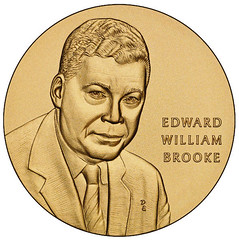

The medal's obverse (heads side), designed and sculpted by United States Mint Sculptor-Engraver Don Everhart, features an image of the senator with the inscription EDWARD WILLIAM BROOKE on the right side. The medal's reverse (tails side) depicts the U.S. Capitol Building at the top and the Massachusetts State House at the bottom between two olive branches. The center of the design showcases the inscription AMERICA'S GREATNESS LIES IN ITS WONDROUS DIVERSITY, OUR MAGNIFICENT PLURALISM HAS MADE THIS COUNTRY GREAT, OUR EVER-WIDENING DIVERSITY WILL KEEP US GREAT. Additional inscriptions on the reverse are ACT OF CONGRESS 2008 and MASSACHUSETTS STATE HOUSE. United States Mint Sculptor-Engraver Phebe Hemphill designed and sculpted the medal's reverse.
To read the complete press release, see: Former U.S. Senator Edward William Brooke III Receives Congressional Gold Medal (www.reuters.com/article/pressRelease/idUS208857+28-Oct-2009+PRN20091028)
I think it was clever of Don Everhart to place his initials on the subject's jacket as if they were a monogram of sorts, but I'm not sure it works. I have the greatest respect for our Mint designers and their work, and they deserve to sign it. But I wonder if these initials are too big and noticeable. Maybe no one will complain, but I'll bet they wouldn't pass muster on a circulating coin. Or maybe as a numismatist I'm just too detail-oriented; perhaps no one will notice. What do readers think?
And what about Phebe Hemphill's reverse design? I'm not sure if the verbiage was mandated by the authorizing legislation, but it seems very wordy. I think it would be a better medal if the Capitol building was center stage. Readers? -Editor
The crisp cadence of a fife-and-drum corps reverberated through the Capitol Rotunda on Wednesday morning, the august room packed with nearly 500 people craning their necks to see the remarkable tableau arranged on a stage before them.
There sat Edward William Brooke III, who grew up in a segregated neighborhood not far from the Capitol, fought in a segregated Army in World War II and returned to Washington in 1967, the first African American elected to the Senate by popular vote -- and on this day, the recipient of the highest honor Congress can bestow, the Congressional Gold Medal.
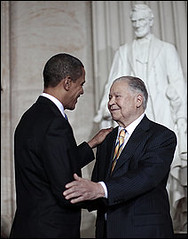 And there sat President Obama, whose stunning electoral journey to the White House seemed no more improbable than the one made four decades earlier by the 90-year-old man who sat beside him, a black Protestant Republican who won in the overwhelmingly white, Catholic, Democratic state of Massachusetts. After Obama heralded Brooke for a life spent "breaking barriers and bridging divides," the two men embraced tightly. It was a reminder of how much this country has changed in their lifetimes.
And there sat President Obama, whose stunning electoral journey to the White House seemed no more improbable than the one made four decades earlier by the 90-year-old man who sat beside him, a black Protestant Republican who won in the overwhelmingly white, Catholic, Democratic state of Massachusetts. After Obama heralded Brooke for a life spent "breaking barriers and bridging divides," the two men embraced tightly. It was a reminder of how much this country has changed in their lifetimes.
To read the complete article, see: An honor for a Senate pioneer (www.washingtonpost.com/wp-dyn/content/article/2009/10/28/AR2009102805119.html)
MORE ON U.S. MINT DIRECTOR JAY JOHNSON
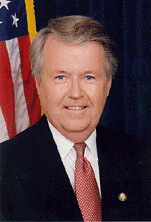 We were saddened to hear about the passing of Jay W. Johnson (1943-2009) who spent over 30 years as a network journalist (television and radio), served as a Congressman from Wisconsin, and then served two years as the 36th Director of the U. S. Mint from 2000-2001.
We were saddened to hear about the passing of Jay W. Johnson (1943-2009) who spent over 30 years as a network journalist (television and radio), served as a Congressman from Wisconsin, and then served two years as the 36th Director of the U. S. Mint from 2000-2001.
Jay was an Honorary LM of the Bowie, MD Coin Club and a member of the American Numismatic Association. As a Congressman, he voted and advocated for the State Quarter and Golden Dollar programs. As Mint Director he attended our conventions and was a mainstay at the NLG Bash. Teaming up with current American Numismatic Association Governor Wendell Wolka, the skits they performed were some of the most humorous we have ever seen.
Jay also served as MC for the Atlanta ANA Banquet in 2001. At the 2003 ANA he was the first Mint Director to consign coins to the official auction. This distinguished and well spoken person was always available to sign his autograph to anyone who asked. For his service to ANA and our hobby, he received the ANA President's Award in March, 2001. More information will be found at: http://en.wikipedia.org/wiki/United_States_Mint
Jay will always live in our memories as a fine human being who would do anything to advance the hobby of coin collecting and numismatics in general. We have made a donation to ANA in his memory. Rest in Peace.
To read the earlier E-Sylum article, see: U.S. MINT DIRECTOR JAY JOHNSON, 1943-2009 (www.coinbooks.org/esylum_v12n43a07.html)
THE BOOK BAZARRE
ERRATA FROM LAST WEEK'S ISSUE
Jeff Starck's article on Google Books starts on page 92 of the November 2, 2009 issue of COIN World, not page 2 as reported. Sorry for the typo!
To read the earlier E-Sylum article, see: COIN WORLD ARTICLE ON GOOGLE BOOKS AND NUMISMATIC RESEARCH (www.coinbooks.org/esylum_v12n43a08.html)
JP Cota pointed out a glaring geographical error in a headline last week. The Casa da Moeda is not in Lisbon, Portugal, but Panjim, Goa, India. Oops! He writes:
Casa da Moeda is the Portuguese equivalent of 'Mint House'. There is an equivalent Mint House of the same (typical) name in Lisbon, but this particular one is a different building altogether! :-) The Casa da Moeda institution in Goa moved places/buildings from 1510 ownwards over the centuties, but stayed in the capital city Panjim till it ceased operations. Thus, these celebrations are of the official Mint House currently owned by Dr Luis Dias family in Goa and buildingwise, there is no direct correlation with the Mint House in Portugal.
To read the earlier E-Sylum article, see: 175TH ANNIVERSARY FESTIVAL FOR THE CASA DA MOEDA LISBON, PORTUGAL (www.coinbooks.org/esylum_v12n43a17.html)
WHEN ARE 200 ONE DOLLAR BILLS WORTH $10 MILLION?

200 One Dollar Bills is the monumental masterpiece from Warhol's first series of silkscreened paintings and is a powerful declaration of the genesis of Warhol's major contribution to art history. Warhol had already revolutionized American art by restoring representation and objective imagery to painting in the startling guise of common, everyday objects such as Campbell's Soup Cans, comics, magazine advertisements and newspaper headlines in late 1961 to early 1962. But the 'Pop Art' revolution was not complete until Warhol discovered the artistic technique that would give him the freedom to exploit his new approach to subject matter.
Earlier Warhol had painted projected images and used stencils and rubber stamps, as formalist experiments, but silk-screening would prove to be his perfect muse. Screening was a mechanical process, and represented an intervention between the artist and the canvas; but in his usual contradictory manner, Warhol would subvert his own intention of "mechanized art" by using the process to create an unending variety of images of both beauty and emotional impact, as well as ground-breaking influence. The series of "Dollar Bill" paintings were done in March-April 1962 and Warhol's first silkscreens were created from ink drawings he made on acetate, picturing the fronts and backs of one- and two-dollar bills.
The "Dollar Bill" series consist of predominantly small paintings of single dollar bills (some shown front and back), with only 10 paintings of dollar bills done in serial or group formats. .200 One Dollar Bills and .192 One Dollar Bills (collection of Staatliche Museen zu Berlin, Nationalgalerie, Collection Marx, Berlin) are the two largest paintings, one a horizontal format and the other a vertical.
In one other important aspect, .200 One Dollar Bills is a quintessential painting of its time: its provenance is the storied collection of Robert and Ethel Scull. The Sculls' fortune derived from taxi cabs and they were New Yorkers to the core. They were also one of the earliest couples to collect and support the Pop Art movement, moving on from their earlier activities in collecting Abstract Expressionist art of the 1950s.
There is more than one apocryphal story as to the original source for money as a subject for Warhol. In one story Eleanor Ward, the director of Warhol's first major gallery, the Stable Gallery, claimed that she promised Warhol his first one-man show in exchange for a painting of her lucky two dollar bill. In another version, an art and antiques dealer named Muriel Laptow suggested Warhol paint what he liked best, and his answer was "money." The general basis for most of these stories is Warhol's concept of money as a commodity, and the artist famously spoke of how art could be interchangeable with money hanging on the wall.
As the decades pass, Warhol's place in the pantheon of American artists becomes ever more strongly established and the rare major works from the inception of his 'Pop Art' aesthetics, such as .200 One Dollar Bills, are testaments to a pivotal moment in art history.
To read the complete article, see: LOT 22 / ANDY WARHOL / 200 ONE DOLLAR BILLS / silkscreen ink and pencil on canvas (catalogue.sothebys.com/pdf/fullpage?auction=N08592&lots=22)
After I got married, a mention of Warhol reminded me of my old fantasy, and I brought it up to date. I could just hear my wife telling me, "Don't bring that thing in our house! The color's awful and it's got a hole in it for crissakes. If you don't get rid of it, I will."
So I consign it to Sotheby's and it sells for millions. The Shot Red Marilyn became one of Warhol's most famous works. So the check arrives and I say "Remember that picture you were going to throw out?"
Hey, it's my fantasy. It's the only way I'll ever get to say "I told you so" or get the last word in an argument, so let me be.
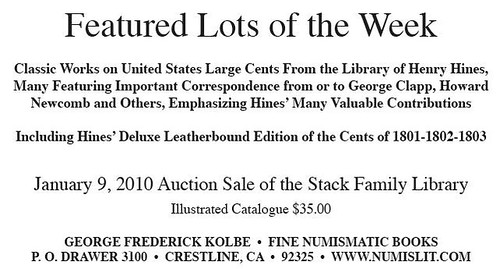
ASHMOLEAN REOPENS AFTER RENOVATIONS
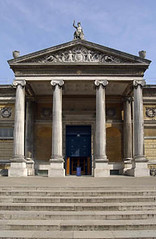 The Ashmolean, Oxford University's 326-year-old museum of art and archaeology, reopens its doors on Nov. 7 after a 61 million pound ($100 million) overhaul.
The Ashmolean, Oxford University's 326-year-old museum of art and archaeology, reopens its doors on Nov. 7 after a 61 million pound ($100 million) overhaul.
The redevelopment, put on show to reporters today, was led by Rick Mather Architects, which modernized London's Wallace Collection. The project will double the display areas of Britain's oldest public museum. There will be 39 new galleries, four exhibition spaces, new education and conservation sections, and the rooftop Ashmolean Dining Room.
The museum's collections are used by students of art history, history, archaeology, numismatics, and Oriental studies.
"For generations, the Ashmolean has provided an outstanding resource for teachers, students and researchers -- as well as a remarkable treasure trove and source of inspiration for visitors of all ages," Oxford Vice-Chancellor Andrew Hamilton said in a news release. With the new extensions, he said, "the special role of the Ashmolean has been secured for generations to come."
The Ashmolean first opened in 1683 to showcase collections given to Oxford University by Elias Ashmole (1617-92).
To read the complete article, see: Oxford University's Ashmolean Reopens After $100 Million Revamp (www.bloomberg.com/apps/news?pid=20601088&sid=aNp8qidFL3aY)
ANCIENT HISTORY AND PSEUDOSCHOLARSHIP
I would not like to sit in the chair of an amateur dentist. Politicians will not finance investigations by amateur nuclear physicists. But when an amateur historian writes a book, no one objects.
Professionalism matters. Much false knowledge will become obsolete once people start to realize that "amateur historian" or "self-taught historian" are just other words for "deficiently trained".
Unfortunately, a professional training is not in itself sufficient to prevent errors. Many historians, philologists, and archaeologists have specialized so much that they are no longer in touch with developments outside their own field.
Scholars have therefore become specialists, and this has two consequences, which, in combination, produce a disastrous outcome. In the first place, students acquire knowledge of one discipline only. An archaeologist has to devote so much time to learning how to dig and recognize finds, that he has almost no opportunity to acquire the necessary command of the ancient languages.
The second consequence of specialization is that no one is sufficiently trained to teach. For example, it can happen that someone who knows everything about the crisis of the third century, must introduce first-year students to the basic outline of ancient history. Because this teacher cannot know everything about every specialization, it is likely that he will offer an outdated account, say, of the Peloponnesian War. Many books written for the larger audience suffer from the same weakness.
Of the fifty mistakes I have discussed in my little book on common errors, thirty-seven were made by people with a Ph.D. speaking on subjects outside their field of competence. In other words, as a guarantee of quality, mutual criticism fails, and the study of Antiquity has become a discipline without quality controls.
To read the complete article, see: Ancient History and Pseudoscholarship (http://www.livius.org/opinion/opinion0017.html)
CAN YOU FOOL A BREATHALYSER BY SUCKING A COPPER COIN?
You may have been told that if you have had too much booze and get pulled over for a Breathalyser test, you should suck on a copper coin.
The theory is that the copper in the penny creates a chemical reaction with the alcohol in your saliva, which results in an inaccurate reading. But even the idea of the copper penny is false since most coins are made from other metals.
And a Breathalyser measures your blood alcohol content by gauging the alcohol level of the air deep within your lungs - not in your spit.
To read the complete article, see:
You know what they say about men with big feet
(www.thesun.co.uk/sol/homepage/features/2708107/
The-truth-about-medical-myths.html)
FEATURED WEB SITE: HANDBOOK OF BIBLICAL NUMISMATICS
This week's Featured Web site is Mel Wacks' Handbook of Biblical Numismatics.
In the Handbook of Biblical Numismatics you will see evidence of Alexander the Great's triumph in the Holy Land. You will even view portraits of two infamous femme fatales -- Cleopatra and Salome.
You will learn that the first strictly Jewish coins were not struck until 40 years after the Syrian King Antiocus VII had granted Simon Maccabeus permission.
You will understand why -- with only isolated exceptions -- no Jewish coins were minted showing a portrait. And you will discover ancient Hebrew inscriptions expressing the struggle for religious freedom and political independence.
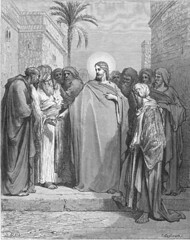
The Tribute Penny
amuseum.org/book/

